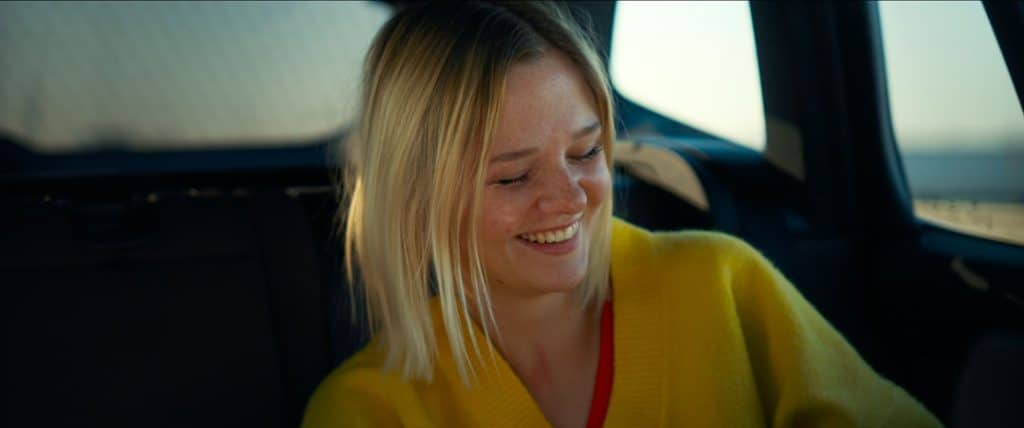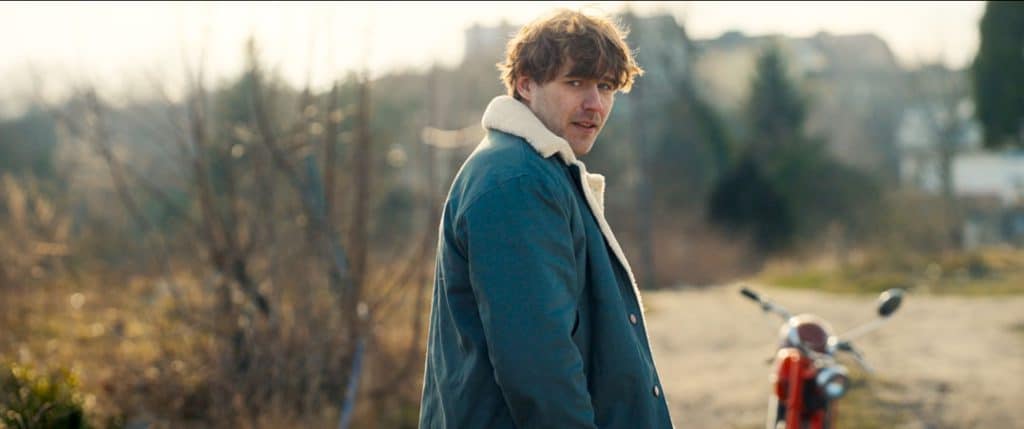WHEN F***ING SPRING IS IN THE AIR – INTERVIEW WITH DANYAEL SUGAWARA
19 AugustHow did you come up with the idea for the film?
I have a Polish mother and feel a strong connection to Poland, especially to the city where my mother is from, Gdynia. I visit Gdynia regularly. During one of my visits, I saw a TV report about Euro-orphans. These are children who have been left behind in Poland by their parents so they can earn better money elsewhere. Some of these children never see their parents again. It deeply affected me to see how some of them grow up in orphanages, while others, who are more fortunate, live with their grandparents. Although I am not an orphan myself, I have a complex relationship with my father, who left us. The absence of a parent can leave deep scars on your self-confidence and the way you form relationships with others. It also affects how you navigate life as a young adult. This subject resonated strongly with me, and I immediately felt that I wanted to make a film about it. Although it’s a heavy theme, I wanted to play with contrasts: love against pain, brutality alongside anger, all laced with humor.
How did you develop the character of Kasia?
Kasia is my favorite character from all the films I’ve made. I see a lot of myself in her, especially the pain, anger, and sadness I felt during my teenage years and young adulthood. At the same time, Kasia also stands entirely on her own. In the beginning, when I was sketching out the story and characters, Kasia was completely different—she was older and had a very different personality. During development, Heleen Suèr and I realized that we needed a stronger and more clearly defined character to give the story more identity. Kasia is our central character and appears in every scene. Her attitude is crucial; she constantly pushes the boundaries of others. This makes her both active and, at the same time, this boundary-pushing behavior leads to constant discoveries and developments, which fuels the audience’s curiosity. Additionally, I feel that there are too few intrinsically strong young women portrayed in films. I grew up in a family full of women, which I think gave me a certain sensitivity that I was able to infuse into Kasia’s character. We consciously chose to create a complex character and resisted feedback from various funds to make her necessarily more sympathetic. In the end, the viewer understands where Kasia’s pain, fear of attachment, fear of abandonment, and her tendency to take initiative come from. She often takes the lead to avoid being rejected. Within our team, we have a fitting description for her: “Kasia is a piece of shit, but a loveable one …”

Why did you ask Heleen Suèr to co-write with you?
I initially started out as a screenwriter, but I have severe dyslexia and have always felt ashamed of it. This eventually led me to choose directing as my focus when I studied at the film academy. During my time there, I met Heleen. She was the mentor for my screenwriter while I was developing my graduation film. That’s how we met, and we had quite a clash back then. I wasn’t an easy student… as I mentioned before, I had a bit of Kasia in me during that time as well. Strangely enough, we also had a lot of respect for each other, and after my time at the academy, we reconnected and ended up making a mid-length film together.
How did your collaboration go?
When I had a basic outline for “Fucking Spring,” I realized I enjoyed co-writing with someone, and Heleen was the person I wanted to embark on that journey with. As a mother of two adopted children, I knew the theme would resonate deeply with her—and it did. Our collaboration went exceptionally well. We alternated writing versions, where one of us would draft a version, and the other would then revise or expand on it. We discussed each other’s work, incorporated suggestions, and processed feedback. The process was so natural that we sometimes don’t even remember who contributed what.
Where did you film?
I wrote the first version of the script in Gdynia, Poland, in an apartment that I was able to use through connections of my parents. The isolation provided the perfect environment for total concentration. In that version, the slum where Kasia now lives was missing, and the first act didn’t flow well. On the advice of local friends, I visited the Pekin district, a hilly area full of self-built houses, once inhabited by dockworkers. This area, once bustling, was on the verge of being transformed into a luxury villa district by developers. This discovery became the film’s opening: Kasia and her grandmother are forced to leave their home for new construction projects. When we wanted to use the location for the film, only two houses were left, a somber reminder of what once was. The scenes set in Poland were filmed in Gdynia, while the others were shot in Germany and the Netherlands. Sometimes we combined locations, such as the interior and exterior of Kasia’s father’s house: the interior shots were done in Utrecht, and the entrance was filmed in Amsterdam.

What memories do you have of the filming period?
We filmed during the peak of Covid and at the beginning of the Russian invasion of Ukraine. Without a doubt, this was the toughest filming period I’ve experienced as a director. To many, it might seem that a director exudes calm and control on set, but internally, there is often a storm raging. The pressure of answering questions directly, making decisions, and dealing with unforeseen circumstances is intense. Covid added an extra layer of stress; our lead actress who played Kasia and my cinematographer both got infected. This led to significant changes in scheduling, rehearsals, and location choices for a film with over 30 speaking roles across three different countries. Despite the challenges, I look back on it with a lot of fondness. There were moments when the script had to be rewritten on the spot due to unexpected problems. But as a team, we overcame many obstacles. My collaboration with Ada (Kasia) was incredibly valuable. Rarely have I worked with an actress who so seamlessly immersed herself in her role. Despite the time lost due to her Covid infection, we were able to catch up a lot thanks to our mutual trust. The collaboration with Adam Palenta, my cinematographer, was also special. It had always been my dream to shoot a film in Poland with a Polish team. Adam brought a deep understanding and a keen eye for human nuances. His contribution was crucial to the film. The film pushed me to my limits, and I learned a lot from that.
How did you choose the cast? What makes them so suitable for their roles?
The casting process for this film had two phases. In 2016, we held a series of castings in Warsaw, with plans to film the following year. During this process, we found the actors for the roles of Kasia, Ewa (mother), and Leszek (father). However, we encountered setbacks when there were changes within the Polish government, leading to the dismissal of many employees at the Polish Film Fund, including those who were enthusiastic about our project. The new members of the film fund, with a more right-wing orientation, rejected our script for political reasons, such as the themes of abortion and parents leaving their children to work abroad. Suddenly, we were left without funding. The search for new financing caused delays, and we had to restart the casting process a few years later, especially since the actress who was supposed to play Kasia had become a mother in the meantime. In the second phase, once the financing was secured, I worked with Paulina Krajnik for almost a year and a half. We considered more than 900 girls for the role of Kasia, most of whom sent in self-tapes, and the final 30 did live auditions. We were looking for a complex character for Kasia; someone who initially seems unsympathetic but eventually reveals a deeper, more vulnerable side. She also needed to have humor and be able to carry the film. Ada was the perfect choice. She understood Kasia’s character from the inside out, which is often a strong element in casting. Utilizing the personal experiences of actors adds depth and empathy to their roles.
The film is very striking in terms of design, titles, dialogue, and music. Can you tell us more about the creation of the music?
In my view, music functions as a character because it resonates with the viewer on a subtle level. In “Fucking Spring,” we used music to express the theme of guilt. Living in the past is often tied to guilt, while a fixation on the future is linked to fear. Truly living in the present means balance. Kasia and her family are anchored in their painful past. The parents ignore their own emotions and have distanced Kasia to minimize their own feelings of guilt. When I worked with Théophile Moussouni, this was the core idea. Théo, a brilliant composer, immediately came up with some strong concepts. We started with classical music, ranging from Bach to Bizet, and experimented with their motifs and tempos. Eventually, we combined these classical influences with 1980s synthwave, creating a nostalgic yet surprisingly familiar sound. As the film progressed, this music evolved into a more modern and balanced sound, culminating in a hopeful ending that I had envisioned. I hope it resonates with people.